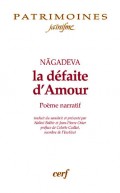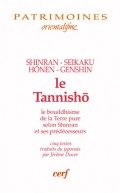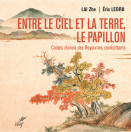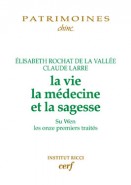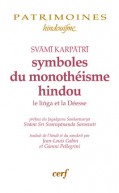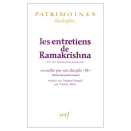
Vessantara-jataka (Le)
Collection Patrimoines - Orient
240 pages - févr. 2010
36,30€
La tradition bouddhique de langue palie a conservé une collection de 547 « Jataka » ou récits de quelques incarnations antérieures du Bouddha de notre ère : comme animal, comme dieu, comme homme. Pour devenir un Éveillé, le Bouddha a dû acquérir des perfections au nombre de dix, et les dix derniers « Jataka » rapportent l’histoire de ces acquisitions. Le plus long de la collection (plus d’un millier de strophes, enrichies de développements en prose), raconte comment le roi Vessantara a conquis la perfection du don : non seulement en offrant de donner, comme son ancêtre Sibi, son propre corps, mais son royaume, sa femme, ses enfants. Surmontant les résistances de sa sensibilité, triomphant des épreuves du changement de conditions qui le mène du trône à la vie d’ascète forestier, d’abord accompagné de sa famille, puis bientôt privé de celle-ci par la convoitise d’un brahmane aussi couard que libidineux et avare, il sort grandi de l’épreuve qui le restitue triomphalement dans sa situation de roi et lui permettra dans l’existence suivante de parvenir à la perfection de l’Éveil comme Bouddha. Poignant (« on lit le Vessantara pour pleurer », dit un proverbe mongol), extrêmement vivant (une succession de dix tableaux prêtant à des peintures comme à des spectacles de théâtre et de marionnettes), politique par sa mise en question de la royauté et des normes de la société hindoue, poétique par son écriture, le « Vessantara-jataka » peut être lu comme une mini-épopée bouddhiste dont l’épopée indienne du Ramayana, pourrait bien être le répondant, voire la réplique. Traduit en français pour la première fois, ce texte est le dernier d’une collection de dix considérée en Asie du Sud-Est par les religieux ou même par les politiques (par exemple, les rois de Thaïlande) comme les « classiques de la politique et de l’éthique bouddhistes ».
--
The Buddhist tradition in Pali language has conserved a collection of 547 "Jatakas", narratives recounting previous incarnations of the Buddha of our time: as an animal, as a god, as a man. To become Enlightened, Buddha had to acquire ten perfections, and the last ten "Jatakas" tell the story of how this was accomplished. The longest one in the collection (more than a thousand stanzas, enriched with prose developments), tells how King Vessantara achieved perfection through giving: not only by offering to sacrifice his own body, as his ancestor Sibi had done, but also his kingdom, his wife and his children. After overcoming his own resistance and triumphing over changes in his life (from the throne, he went to being an ascetic living in the forest, first accompanied by his family then deprived of their company by the greed of a cowardly, mean Brahman) he emerged from his ordeal strengthened, and was triumphantly restored as king and permitted, in his subsequent existence, to reach sublime Enlightenment as Buddha. Poignant (a Mongol proverb says "you read the Vessantara to weep"); sparkling (a succession of ten scenes borrow from the visual arts, drama and puppet theatre); political (its challenge to royalty and the values in Hindu society); poetic (writing style): the "Vessantara-jataka" can be read as a Buddhist mini-epic to which the Indian Ramayana could be the response, indeed the rejoinder. Translated into French for the first time, this is the final book in a collection of ten, considered in South East Asia by clerics and even politicians (for example, the kings of Thailand) to be "classics of Buddhist politics and ethics".
--
The Buddhist tradition in Pali language has conserved a collection of 547 "Jatakas", narratives recounting previous incarnations of the Buddha of our time: as an animal, as a god, as a man. To become Enlightened, Buddha had to acquire ten perfections, and the last ten "Jatakas" tell the story of how this was accomplished. The longest one in the collection (more than a thousand stanzas, enriched with prose developments), tells how King Vessantara achieved perfection through giving: not only by offering to sacrifice his own body, as his ancestor Sibi had done, but also his kingdom, his wife and his children. After overcoming his own resistance and triumphing over changes in his life (from the throne, he went to being an ascetic living in the forest, first accompanied by his family then deprived of their company by the greed of a cowardly, mean Brahman) he emerged from his ordeal strengthened, and was triumphantly restored as king and permitted, in his subsequent existence, to reach sublime Enlightenment as Buddha. Poignant (a Mongol proverb says "you read the Vessantara to weep"); sparkling (a succession of ten scenes borrow from the visual arts, drama and puppet theatre); political (its challenge to royalty and the values in Hindu society); poetic (writing style): the "Vessantara-jataka" can be read as a Buddhist mini-epic to which the Indian Ramayana could be the response, indeed the rejoinder. Translated into French for the first time, this is the final book in a collection of ten, considered in South East Asia by clerics and even politicians (for example, the kings of Thailand) to be "classics of Buddhist politics and ethics".
- Dimensions : 145x235x15
- ISBN : 9782204089821
- Poids : 370 grammes
Avec la collaboration de : Jean-Pierre Osier
DU MÊME AUTEUR
> VOIR TOUS LES LIVRES DE l'AUTEUR
DANS LA CATÉGORIE SAGESSES ET CULTURES D'ASIE
Entre le ciel et la terre, le papillon
Contes chinois des Royaumes combattants
de LAI Zhe ,LEDRU Éric
184 pages - oct. 2023
La Vie, la médecine et la sagesse
d' Elisabeth Rochat de la Vallée ,Claude Larre
408 pages - mai 2005
Les Entretiens de Ramakrishna
(Shri Shri Ramakrishna Kathamrita) recueillis par son disciple «M» (Mahendranath Gupta)
de Ramakrishna
368 pages - janv. 1996

